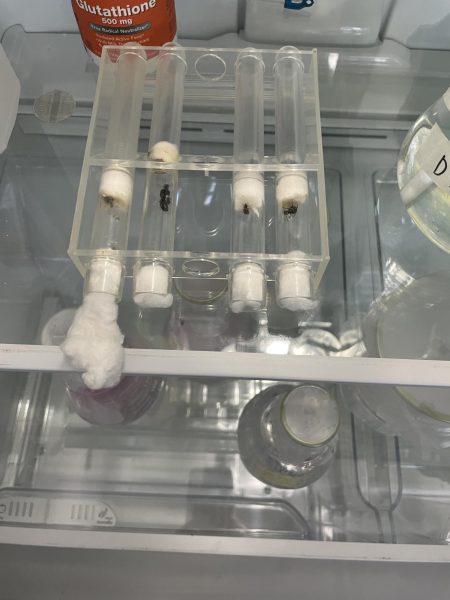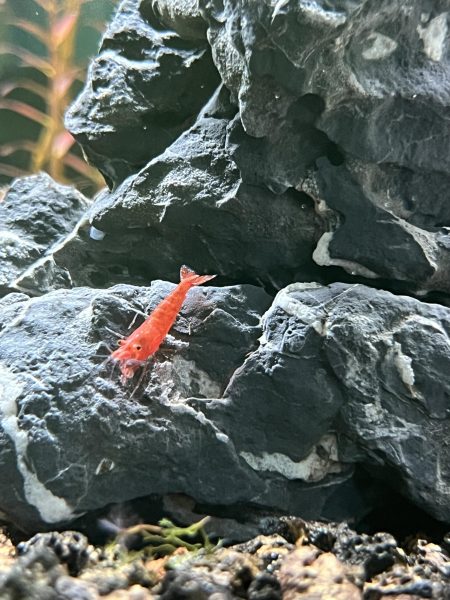Bug infestations and insects, in general, are a large source of discomfort for most of the population. However, when sophomore Lam Le was young, an insect invasion ignited a lasting interest in arthropods, specifically ants.
“When I was a kid and my houses dealt with a lot of bugs … I grew up around ants,” Le said. Carrying over his interest in entomology, the study of insects, from his childhood, he continues to pursue research relating to invertebrates.
Le plans to start four small ant colonies in the school’s Advanced Science Research (ASR) classroom. Le explains: “My parents don’t like me keeping them in the house, so I brought them here to school.”
Ants, in many ways, are the most accessible type of insect to keep. “They’re not like other social insects; they’re easier to keep than bees [and it’s] cheaper,” Le described. “They are pretty low maintenance.” Aside from feeding them sugar from time to time or observing them, Le leaves the ants alone.

Early last year, his old colony passed away from old age, so Le collected four new queen ants to start anew. He plans to work with three species: two Lasius ants, one Camponotus (carpenter) ant and one Formica ant. Currently, these ants are being kept in the ASR room’s fridge to simulate hibernation for the wintertime.
Le started his colonies by finding his ants in the wild. “You can catch the queen ants easily; you just got to pay attention,” Le said. Queen ants are distinguishable by their larger abdomen and wings or wing scars. Once the queen ant is captured, it must be placed in a test tube set-up and kept in dark conditions with ample water, prompting the queen to start laying eggs. Soon after, worker ants will begin to populate and grow the colony.
Colonies can also be obtained by finding and digging them up in the wild; however, Le warns against this method. “I [have] dug up a colony, but my parents weren’t happy about that,” Le said. He later returned them to the wild after persistent pushback.
Le is presently involved in an ASR project studying solitary bees and hopes to continue his insect-focused research beyond SPA. The four ant colonies are still too small to run experiments or collect data on, but Le plans to catch more insects this spring to grow his collection, observing and monitoring their behaviors and growth.
Similarly, sophomore Ethan He is another proud owner of a few creatures, including crabs, shrimp, a turtle and fish.

Like Le, he grew curious about aquatic animals at a young age through exposure to these creatures. “When I was in Taiwan, there were like a bunch of streams [with] shrimp in them [that] I used to catch [to] put in my turtle tank,” He said. “I’d go to any random river, and I [collected them with] a big cup and a stick.”
When He moved to America, not only did he have to leave his turtle behind, but he also had to change his method of crustation collection. “[In Taiwan] you flip a rock and there’s maybe a crab or something … here I just go to a store to buy it,” He said.
Presently, He keeps two tanks at home to store his creatures. One is a half-land tank to store his crabs, and the other is fully submerged to house his fish and shrimp.
The species of crab He keeps are called vampire crabs, distinctly known for their orange, purple, or blue coloring. “I initially had three of them but then they bred so now I have a lot and I can’t count them up,” He said.
Because of the rapid population growth in the crabs, He is thinking of selling a couple in exchange for a wider variety of fish, a single vampire crab going for around $18. His current fish population includes plecos, guppies and gouramis.
His shrimp population contains two different species; vampire and cherry shrimp. Cherry shrimp are very common, bright red and only an inch long, while vampire shrimp are around three inches long, have fan-shaped arms and can eat above the water.
[In Taiwan] you flip a rock and there’s maybe a crab or something … here I just go to a store to buy it.
— Ethan He
Taking care of his sea creatures is also a relatively low-effort task. “They eat whatever, so you don’t even need to feed them. They eat like plants, algae,” He explained. Everything the animals need to survive is planted and growing in the tank.
He and Le have carried their fascination with insects and sea creatures since childhood, inspiring them to take care of and strive to learn more about them. Despite owning very different sectors of the animal world, they can agree that their favorite thing about owning their menagerie of creatures is simply watching and observing them. “They always look cool… [especially when they] eat stuff,” He said.